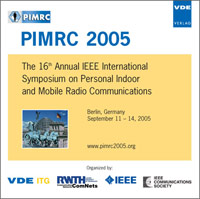A Two-Channel Medium Access Control Protocol for Mobile Ad Hoc Networks using Directional Antennas
Conference: PIMRC 2005 - 16th Annual IEEE International Symposium on Personal Indoor and Mobile Radio Communications
09/11/2005 - 09/14/2005 at Berlin, Germany
Proceedings: PIMRC 2005
Pages: 5Language: englishTyp: PDF
Personal VDE Members are entitled to a 10% discount on this title
Authors:
Pan, Yuxin; Hamouda, Walaa; Elhakeem, Ahmed (Department of Electrical and Computer Engineering, Concordia University, Montreal, Quebec, HEG 1M8, Canada)
Abstract:
In recent years, the use of directional antennas in wireless networks has been widely studied . Since the Medium Access Control (MAC) protocol of the IEEE 802.11 standard is designed for the use of omnidirectional antennas, it cannot perform efficiently when directional antennas are used. In this paper, we study the performance of an efficient two-channel MAC protocol for ad hoc networks when equipped with directional antennas. The proposed protocol utilizes the large throughput offered by directional antennas using two frequency division multiplexed channels. The first channel is used for control information and the second for user data transmission. Based on this, the proposed MAC protocol operates in two main modes, the omnidirectional mode where one antenna is used for the transmission of users’ control frames, and the directional mode where antenna arrays are used for the transmission of data frames. The proposed protocol is assessed using computer simulations based on randomly generated network topologies reflecting the random movement of nodes in the network. Based on these random topologies, we present performance comparisons with the existing MAC protocols using different system parameters. In all cases, the proposed MAC protocol is shown to offer a significant throughput improvement relative to the existing protocols.


